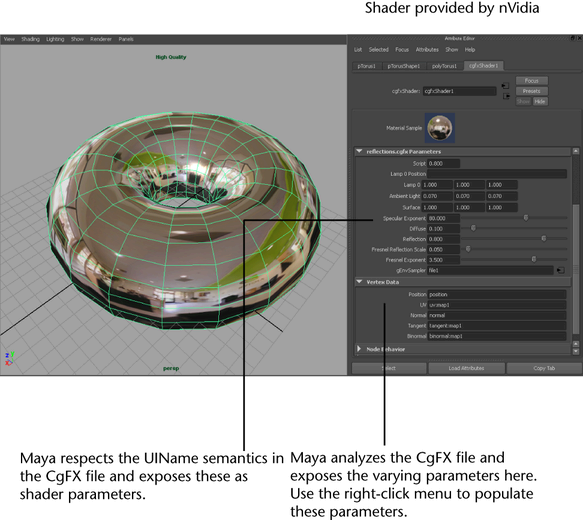Before you can create a , you must first load the CgFX plug-in. See Work with CgFX shaders for more information.
Writing a
Maya supports Cg version 3.0.015.
CgFX examples are shipped with the Maya software. You can find these examples at:
- (Windows) <drive>:\Program Files\Autodesk\Maya2012\presets\CgFX\examples
- (Mac OS X) /Applications/Autodesk/Maya2012/Maya/Contents/presets
- (Linux) /usr/autodesk/maya2012/presets/CgFX/examples
Varying parameter packing
You can pack multiple mesh inputs into a single varying parameter register. For example, you can pack two sets of UV coordinates
into a single float4 register.
The following is a sample workflow:
- The following vertex shader input structure shows a packed float4 that needs to contain 2 UV sets in a single varying parameter:
struct appdata { float3 Position: POSITION; float4 UVs: TEXCOORD0; };
- Create a second structure that describes the elements that should be packed into this input. To enable Maya to locate this
second structure, its name must match the name of the original varying parameter (in this case, UVs).
In this example, this auxiliary structure informs Maya that the original float4 parameter should be assembled on the fly from two float2 inputs: one named UV1, and one named UV2. This structure is not used by the shader itself - it simply tells Maya how to assemble the data for this input.
struct UVs { float2 UV1; float2 UV2; };
- Because Maya knows that this is a packed input, it presents the artist with an interface to the underlying data (UV1 and UV2) rather than the final packed structure (UVs). You can now optimize and reorganize the varying parameter register assignment without breaking any existing shader bindings
in scenes using the shader.
For more information, see UVPacking.cgfx as an example.
Note
Where the data assigned to a structure element is too large for the Cg data type specified (for example, a position with (x,
y, z) coordinates is passed into a float2 value), the first n values will be used to populate the value, and any subsequent elements will be ignored (for example,
x and y will be passed in, and z will be ignored).
Other features
-
-
Maya supports parameters that vary by time. See MrWiggle.cgfx for an example of a shader that moves with time.
-
-
You can specify matrices in your . Maya supports all matrix semantics keywords.
- Transparent CgFX shaders
-
Maya supports rendering of transparent CgFX shaders. Maya detects whether the blending state is enabled in the first pass.
If blending is enabled, Maya uses the or options in the scene view to correctly render the transparent shader.
- Maya shader files
-
Maya provides shader files that developers can incorporate into their own CgFX shader, in the following directory:
- (Windows) <mayapath>\bin\cg
- (Linux) <mayapath>/bin/cg
- (Mac OS X) <mayapath>/Maya.app/Contents/bin/cg
Select a Maya_*.cgh code example; for example, maya_blends.cgh, the code that Maya uses for blending of the layered texture:
- Orientation for the texture co-ordinate system
-
Beginning Maya 2012, when the CgFx plug-in compiles a CgFx shader, it sets the compilation macro MAYA_TEXCOORD_ORIENTATION
to either OpenGL or DirectX to specify the orientation used for the texture co-ordinate system. For more information, see
Orientation for the texture co-ordinate system.
- Customizing your CgFX shaders
-
You can use the MAYA_CGFX macro to customize your CgFX shaders to include Maya specific attribute annotations without breaking
the compatibility with other applications that might also use the same CgFX shader. For more information, see
Customizing your CgFX shaders.
for the include:
- Maya only supports .cgfx files and not .cg
- Pre and post effects (for example, full-screen effects)
- Pass scripting
- Cg Interfaces
- Time semantic: When using a shader that moves with time, you must refresh the scene in order to see the animation, for example,
by tumbling the camera.
